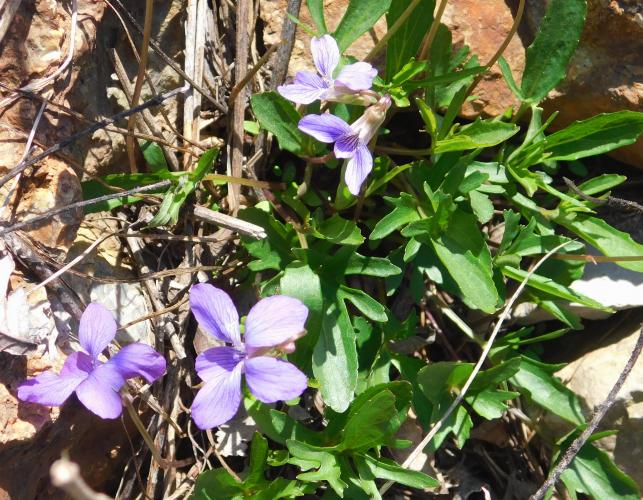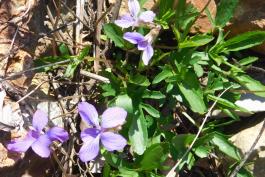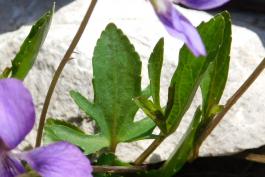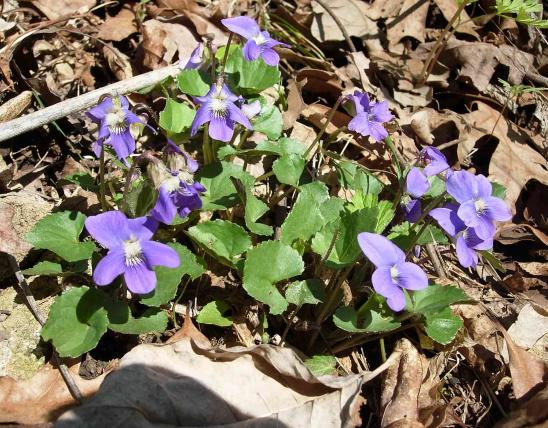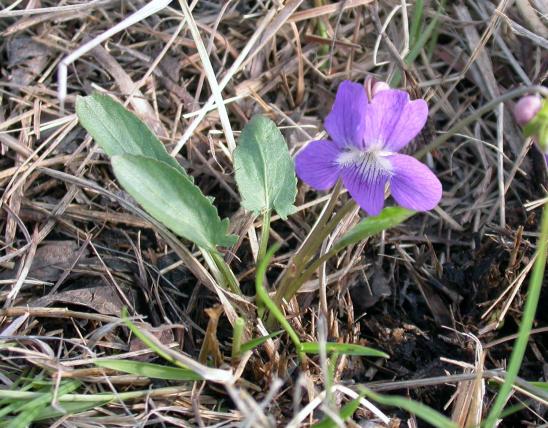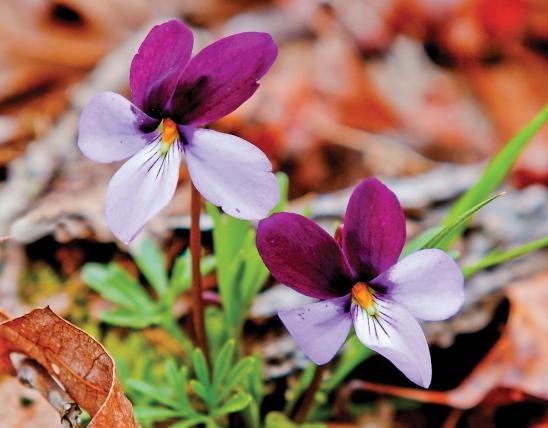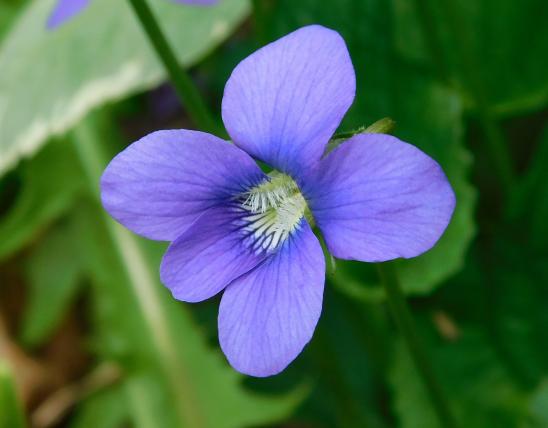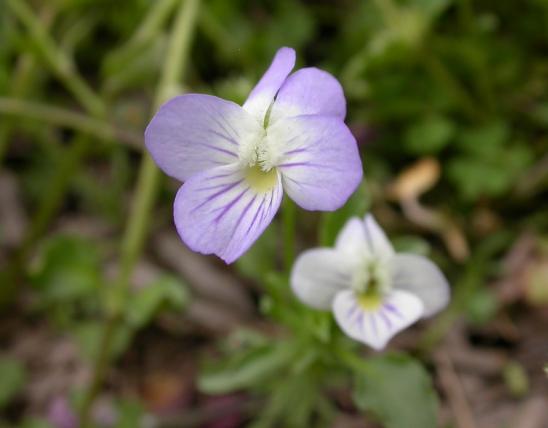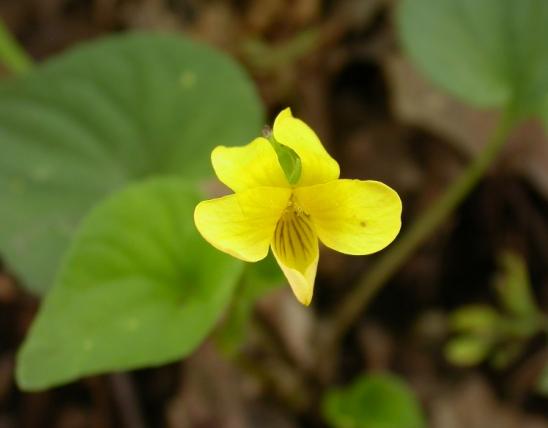
Plains violet, or wayside violet, is a native Missouri perennial wildflower. Like most of our other violets, it lacks a true aboveground stem; the leaf stems and flower stems each attach separately, in a whorl, to the rootstock. Its bluish or purple flowers resemble those of many other violets. It blooms April–May.
The leaf blade shape, however, is distinct, and it changes with the season. Unless you’re looking at it very early in spring, you’ll probably find different leaf shapes on the same plant. In early spring, the first leaves produced are unlobed and more or less rounded; late in the growing season, the plant may again produce such unlobed leaves. But starting in midspring, the plant produces leaves that are often 3- or 5-lobed (or more), usually irregularly cleft; the lobes may have irregular teeth, as well. The central lobe is at least about ¼ inch wide and is often wider than the lateral lobes; the central lobe may be lanceolate to triangular-ovate. Also note that plains/wayside violet is a smooth (glabrous) (not hairy) plant.
Plains or wayside violet is most likely to be confused with cleft violet (V. palmata). Plains/wayside violet is distinguished from that species by its glabrous (not hairy) leaf blades; also, the cleistogamous (nonopening) flowers/fruits of plains/wayside violet, which form low on the plant, usually hidden beneath the leaves, are on long, erect, or strongly ascending stalks (not short, arched or spreading), the surface uniformly purple (not dark green mottled with purple).
To learn more about Missouri's violets (genus Viola) as a group, visit their group page.
Similar species: Missouri has five species of stemless blue/purple violets with unlobed leaf blades that are always either heart-shaped, kidney-shaped, or rounded; one example is the aptly named common violet (V. sororia). In early spring, plains/wayside violet plants that haven’t yet developed mature leaves may be mistaken for any of those five species. The flowers may be virtually identical.
More confusing, however, are Missouri’s two other stemless blue/purple violets that, like plains/wayside violet, also have lobed leaf blades with a wide central lobe plus lateral lobes:
- Cleft violet (V. palmata) is very similar to plains/wayside violet. It’s scattered nearly statewide, but less abundant in the glaciated and unglaciated plains of northern and western Missouri. It occurs in rich upland forests, bases, ledges, and tops of bluffs, banks of streams and rivers, also along railroads and roadsides. Like plains/wayside violet, the leaf blade shape typically changes with the season with shapes very similar. Some botanists consider plains/wayside violet to be a variety of the cleft violet species. As noted above, plains/wayside violet is distinguished from cleft violet by its glabrous (hairless) leaf blades; also, the cleistogamous flowers/fruits are on tall, erect stalks, the surface uniformly green.
- Arrow-leaved, arrowhead, or arrowleaf violet (V. sagittata) is scattered nearly statewide but is uncommon or absent from the Bootheel lowlands and the western half of the glaciated plains of northern Missouri. It occurs in dry prairies, sandstone glades, and edges or clearings of open oak forests, on dry to seasonally somewhat moist or gravelly sand. Relatively widespread in Missouri but apparently nowhere very abundant. In mature plants, the shape of the leaf blade is unique: longer than wide, with a single large, oval or triangular central lobe; additional lobes occur only at the basal 1/3 of the blade and are rather short, less than 1/3 the length of the midvein.
Missouri has two other lobed-leaved, stemless blue violets: bird’s foot violet (also called pansy violet or hens and roosters, V. pedata), and prairie violet (or larkspur violet, V. pedatifida). These, however, have leaf lobes that are all narrow, like a bird’s foot.
Height: to 12 inches.
Uncommon, widely scattered in the state.
Habitat and Conservation
Occurs on banks of streams and rivers, on bases and crevices of bluffs, and rarely in bottomland prairies; also on railroads and roadsides.
Status
Native Missouri perennial wildflower. Like most other Missouri violets, it can be used in native wildflower gardening.
This unusual plant, which was first described based on plants collected along railroads in the St. Louis area, appears to be relatively uncommon throughout its range, which extends from Illinois to South Dakota south to Arkansas and Oklahoma.
Botanists have debated the taxonomic status of Viola viarum. Some have concluded that it is closely related to the Missouri violet (V. missouriensis). Some botanists contend that it should not be considered a full species and treat it as a hairless form of cleft violet (V. palmata). Some consider it a hybrid descendant of prairie/larkspur violet (V. pedatifida) plus some other species of stemless blue violet, such as Missouri violet or blue prairie violet (V. nephrophylla). Further research should help sort out its status.
Human Connections
The species name, viarum, means “road” or “pathway,” so the common name “wayside violet” is basically a translation of the scientific name. Considering it was first collected along railroads — and it occurs along roadways, streams, and rivers, all pathways of a sort — it’s an appropriate name. The name “plains” violet seems less appropriate, except perhaps in a broad, regional sense.
Violets are a favorite sign of springtime in Missouri. They are enjoyed by native wildflower gardeners as blooming groundcovers or naturalized in woodland plantings or in rock gardens. Though rather small, they are gratifying to grow, since they are valuable to wildlife ranging from butterflies to the variety of birds and mammals that browse their leaves and fruit capsules. Some species are easier to cultivate than others. Get starts of these plants from reputable wildflower nurseries.
The attractive flowers of the stemless blue-flowered violets are used to make a beautiful jelly. They can also be candied for unique confections and garnishes, and they can be eaten in salads (though the flavor is bland). The leaves also hold significant amounts of vitamin C and are edible as a nutritious potherb in spring. The young foliage of most stemless blue violets can be eaten raw or cooked, with a mucilaginous texture similar to that of okra. Throw some in with your other salad greens.
Violets have historical uses globally as medicinal plants, and modern researchers are investigating a wide array of potential pharmaceutical properties.
Seeing an unusual form of a plant for the first time is a genuine thrill. Many species of Missouri violets are more common and may be quite familiar. But if you’re in the right place at the right time, seeing your first wayside violet can really make your day.
Ecosystem Connections
Violets are the food plants for the caterpillars of several kinds of moths and butterflies, including the giant leopard moth, the regal fritillary, plus most other fritillary species, which are all colorful, medium-sized to large butterflies.
Pollination is carried out by various flies, bees, butterflies, and more.
Like many other perennial herbaceous wildflowers, Missouri’s violets help hold the soil, preventing erosion, and provide forage for many herbivorous animals. Many songbirds, rodents, and other animals eat the seeds.
The nonopening, cleistogamous flowers, which typically begin to form later in the spring and summer, are a strategy that helps these rather small wildflowers to reproduce even when larger plants start to cover them, making them more difficult for pollinators to find.
Plains/wayside violets have interesting leaves, don’t they! Botanists describe plants that produce different types of leaves as heterophyllous (het-er-oh-fill-us). Heterophylly can be triggered by different growing conditions or by seasonal changes programmed into the plant’s life cycle. The different leaf shapes typically maximize their efficiency as the environment or season changes. Here are some examples:
- In several aquatic plants, such as water plantains (Alisma spp.) and burheads (Echinodorus spp.), the plants begin with ribbon-shaped underwater leaves, then later develop emergent leaves with well-defined leaf stalks and oval or paddle-shaped blades.
- Sweet gum trees produce differently shaped leaves, too. Early spring leaves, which develop from buds that overwintered, are rather small and have very shallow lobes. As the season progresses, the tree produces new leaves that grow to larger sizes and have longer lobes. In late season, the leaves are small again but have the deepest lobes of all.
- Coriander (cilantro) produces differently shaped leaves as the plant matures. Early leaves, lower on the plant, have broad lobes, while later leaves that develop higher on the plant, as the plant begins to bloom, are finely dissected and feathery.
